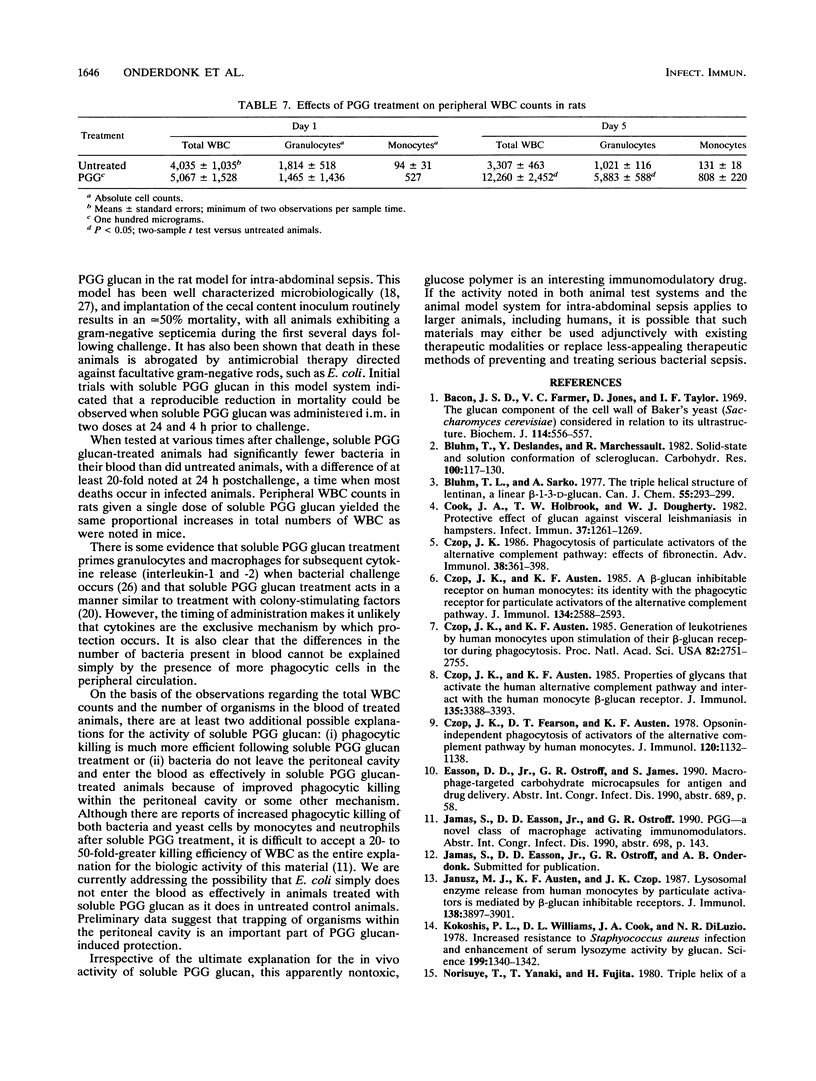Abstract
Mice challenged with Escherichia coli or Staphylococcus aureus were protected against lethal peritonitis by the intravenous administration of 10 micrograms of poly-beta 1-6-glucotriosyl-beta 1-3-glucopyranose (PGG) glucan per animal 4 to 6 h prior to bacterial challenge. Subsequent studies with the rat model for intra-abdominal sepsis indicated that intramuscular doses of 10 to 100 micrograms per animal 24 and 4 h prior to surgical implantation of the bacterial inoculum reduced the early mortality associated with the peritonitis phase of this experimental disease process. Quantitative cultures of blood obtained from challenged rats showed that significantly fewer organisms were present in the blood of PGG glucan-treated animals than in that of untreated animals. Quantitative studies of leukocytes of rats and mice following a single injection of PGG glucan showed a modest transient increase in the total leukocyte count. The possible mechanisms by which protection occurs in the animal model system are discussed.
Full text
PDF





Selected References
These references are in PubMed. This may not be the complete list of references from this article.
- Bacon J. S., Farmer V. C., Jones D., Taylor I. F. The glucan components of the cell wall of baker's yeast (Saccharomyces cerevisiae) considered in relation to its ultrastructure. Biochem J. 1969 Sep;114(3):557–567. doi: 10.1042/bj1140557. [DOI] [PMC free article] [PubMed] [Google Scholar]
- Cook J. A., Holbrook T. W., Dougherty W. J. Protective effect of glucan against visceral leishmaniasis in hamsters. Infect Immun. 1982 Sep;37(3):1261–1269. doi: 10.1128/iai.37.3.1261-1269.1982. [DOI] [PMC free article] [PubMed] [Google Scholar]
- Czop J. K., Austen K. F. A beta-glucan inhibitable receptor on human monocytes: its identity with the phagocytic receptor for particulate activators of the alternative complement pathway. J Immunol. 1985 Apr;134(4):2588–2593. [PubMed] [Google Scholar]
- Czop J. K., Austen K. F. Generation of leukotrienes by human monocytes upon stimulation of their beta-glucan receptor during phagocytosis. Proc Natl Acad Sci U S A. 1985 May;82(9):2751–2755. doi: 10.1073/pnas.82.9.2751. [DOI] [PMC free article] [PubMed] [Google Scholar]
- Czop J. K., Austen K. F. Properties of glycans that activate the human alternative complement pathway and interact with the human monocyte beta-glucan receptor. J Immunol. 1985 Nov;135(5):3388–3393. [PubMed] [Google Scholar]
- Czop J. K., Fearon D. T., Austen K. F. Opsonin-independent phagocytosis of activators of the alternative complement pathway by human monocytes. J Immunol. 1978 Apr;120(4):1132–1138. [PubMed] [Google Scholar]
- Czop J. K. Phagocytosis of particulate activators of the alternative complement pathway: effects of fibronectin. Adv Immunol. 1986;38:361–398. doi: 10.1016/s0065-2776(08)60011-5. [DOI] [PubMed] [Google Scholar]
- Janusz M. J., Austen K. F., Czop J. K. Lysosomal enzyme release from human monocytes by particulate activators is mediated by beta-glucan inhibitable receptors. J Immunol. 1987 Jun 1;138(11):3897–3901. [PubMed] [Google Scholar]
- Kokoshis P. L., Williams D. L., Cook J. A., Di Luzio N. R. Increased resistance to Staphylococcus aureus infection and enhancement in serum lysozyme activity by glucan. Science. 1978 Mar 24;199(4335):1340–1342. doi: 10.1126/science.628841. [DOI] [PubMed] [Google Scholar]
- Onderdonk A. B., Weinstein W. M., Sullivan N. M., Bartlett J. G., Gorbach S. L. Experimental intra-abdominal abscesses in rats: quantitative bacteriology of infected animals. Infect Immun. 1974 Dec;10(6):1256–1259. doi: 10.1128/iai.10.6.1256-1259.1974. [DOI] [PMC free article] [PubMed] [Google Scholar]
- PHAFF H. J. CELL WALL OF YEASTS. Annu Rev Microbiol. 1963;17:15–30. doi: 10.1146/annurev.mi.17.100163.000311. [DOI] [PubMed] [Google Scholar]
- Patchen M. L., MacVittie T. J. Hemopoietic effects of intravenous soluble glucan administration. J Immunopharmacol. 1986;8(3):407–425. [PubMed] [Google Scholar]
- RIGGI S. J., DI LUZIO N. R. Identification of a reticuloendothelial stimulating agent in zymosan. Am J Physiol. 1961 Feb;200:297–300. doi: 10.1152/ajplegacy.1961.200.2.297. [DOI] [PubMed] [Google Scholar]
- Reynolds J. A., Kastello M. D., Harrington D. G., Crabbs C. L., Peters C. J., Jemski J. V., Scott G. H., Di Luzio N. R. Glucan-induced enhancement of host resistance to selected infectious diseases. Infect Immun. 1980 Oct;30(1):51–57. doi: 10.1128/iai.30.1.51-57.1980. [DOI] [PMC free article] [PubMed] [Google Scholar]
- Saitô H., Ohki T., Sasaki T. A 13C nuclear magnetic resonance study of gel-forming (1 goes to 3)-beta-d-glucans. Evidence of the presence of single-helical conformation in a resilient gel of a curdlan-type polysaccharide 13140 from Alcaligenes faecalis var. myxogenes IFO 13140. Biochemistry. 1977 Mar 8;16(5):908–914. doi: 10.1021/bi00624a015. [DOI] [PubMed] [Google Scholar]
- Sherwood E. R., Williams D. L., McNamee R. B., Jones E. L., Browder I. W., Di Luzio N. R. Enhancement of interleukin-1 and interleukin-2 production by soluble glucan. Int J Immunopharmacol. 1987;9(3):261–267. doi: 10.1016/0192-0561(87)90049-x. [DOI] [PubMed] [Google Scholar]
- Weinstein W. M., Onderdonk A. B., Bartlett J. G., Gorbach S. L. Experimental intra-abdominal abscesses in rats: development of an experimental model. Infect Immun. 1974 Dec;10(6):1250–1255. doi: 10.1128/iai.10.6.1250-1255.1974. [DOI] [PMC free article] [PubMed] [Google Scholar]
- Williams D. L., Cook J. A., Hoffmann E. O., Di Luzio N. R. Protective effect of glucan in experimentally induced candidiasis. J Reticuloendothel Soc. 1978 Jun;23(6):479–490. [PubMed] [Google Scholar]


